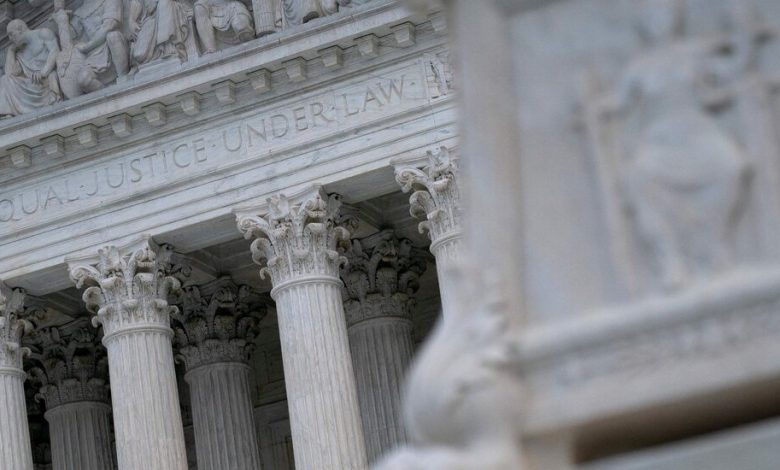John Roberts Throws a Curveball

The Supreme Court’s voting rights ruling on Thursday in Allen v. Milligan is as shocking as it is welcome. The Voting Rights Act has lived to see another day, with implications for 2024 and beyond.
The court ruled that Section 2 of the Voting Rights Act requires Alabama to draw a second majority-Black congressional district in which its voters can elect the candidate of their choice. In an opinion written by Chief Justice John Roberts and joined by Justices Ketanji Brown Jackson, Elena Kagan, Brett Kavanaugh and Sonia Sotomayor, the court also reaffirmed Section 2’s constitutionality and beat back Alabama’s arguments that the race-conscious statute should be read in a race-neutral way.
Milliganis not a ruling that expands minority voting rights. But had the dissenting justices — Samuel Alito, Amy Coney Barrett, Neil Gorsuch and Clarence Thomas — gotten their way, it would have decimated effective minority representation as Congress, statehouses, county and school boards and city councils became much whiter and less broadly representative.
The big mystery is why Chief Justice Roberts would write an opinion confirming that race-based remedies in politics are sometimes appropriate, given his role in 1982 as President Ronald Reagan’s point man opposing the expansion of Section 2, his 2013 opinion in Shelby County v. Holder striking down as unconstitutional another key part of the act and numerous recent decisions reading the act narrowly.
It’s possible that he had a change of heart, but it’s more likely that his institutionalist side kicked in.
He may have sided with Black Alabamians because he has genuinely changed his skeptical views about race-conscious remedies since he wrote the opinion for Shelby County, a case he did not even cite in his opinion in Milligan. He could have seen Milligan as simply applying well-settled precedents. But as recently as last year, when Alabama sought a stay before the 2022 elections of the lower-court ruling the court just affirmed, Chief Justice Roberts suggested rethinking or tinkering with those precedents even as he opposed the stay. (Justice Kavanaugh joined the other conservatives in imposing the stay, but he said he did so because the lower-court ruling came too close to the election, not on the merits of Alabama’s arguments on appeal.)
But perhaps a more plausible answer for the chief justice’s blinking is that he could foresee the additional social upheaval and opprobrium that would have been generated against the Supreme Court had it ended significant minority representation in Congress and statehouses. Showing the court as an institution sometimes willing to side with minority plaintiffs could prove very important, especially if, as expected, Chief Justice Roberts and Justice Kavanaugh soon join the other conservative justices in rejecting race-based affirmative action in college admissions.
Why were so many court watchers, including me, expecting a different decision in this case? Since Congress passed the Voting Rights Act in 1965 and amended it in 1982, the Supreme Court has repeatedly weighed in on its scope and meaning. Section 5 required states and localities with a history of racial discrimination in voting to get federal approval before changing their voting rules, with the burden of demonstrating that those changes would not make minority voters worse off. The court repeatedly upheld the constitutionality of Section 5.
By 2013, however, the court held that Congress no longer had the power to require federal preapproval of voting changes. In Shelby County, Chief Justice Roberts declared that “history did not end in 1965” and that considerable improvement in the South made continued federal oversight unconstitutional.
Section 5 prevented states from making minority voters’ situations worse, but it did little to improve minority representation in Congress and in other legislative bodies in which white voters consistently defeated candidates preferred by minority voters. The Supreme Court initially read the 15th Amendment as providing some requirement for minority voters to get a fair chance at representation, but the court shut that down in a 1980 case, City of Mobile v. Bolden. In response, in 1982 Congress rewrote Section 2 of the Voting Rights Act to give minority voters that chance.
This was the state of affairs when Mr. Roberts was working for the Reagan administration to prevent an expansive rewriting of Section 2. Eventually, Congress settled on a compromise brokered by Senator Bob Dole, a Republican. The amended Section 2 would protect the ability of minority voters to elect representatives of their choice, provided that it did not guarantee proportional representation. After the Dole compromise, the Supreme Court created a complex legal test in Thornburg v. Gingles that allowed minority voters to win some but far from all cases challenging district lines.
Since Gingles, the court has weighed in many times on Section 2’s meaning and scope, and in recent years conservatives have read the scope of the act less expansively. For example, it rejected a challenge to Texas’ redistricting in 2018, insisting that courts give states the benefit of the doubt when they draw district lines. And in 2021 in Brnovich v. Democratic National Committee, the court made it very hard for minority voters to use Section 2 to challenge restrictive voting rules, like voter ID laws.
Milligan put the brakes on the judicial assault on Section 2 without expanding voting rights. It reaffirmed the weakened Gingles test. Given earlier rulings and the court’s emphasis in Milligan on the Dole compromise, the ruling will not lead to a flood of new districts where minority voters can elect candidates of their choice.
But the court did reaffirm the constitutionality of Section 2. In recent years, Voting Rights Act opponents have put forward radical arguments to kill Section 2, recognizing that the new conservative supermajority on the Supreme Court could be receptive. InMilligan, however, the court shut many of these arguments down. In an odd echo of the uncited Shelby County case, Chief Justice Roberts declared in his ruling that “history did not stop in 1960.” His reference to the fact that discrimination is a problem of the present and not just the past was a silent recognition of Justice Ruth Bader Ginsburg’s dissent in Shelby.
In the longer term, the Voting Rights Act is not necessarily safe. Writing separately, Justice Kavanaugh signaled that plaintiffs could try to bring a Shelby-like argument against Section 2 in a future case, arguing that conditions have changed enough that this part of the act, too, once constitutional, no longer is.
And that leaves the question of why Chief Justice Roberts let the Voting Rights Act live, given his earlier skepticism of race-based remedies. After all, this is the justice who famously declared in a 2007 case involving affirmative action in schools that “the way to stop discrimination on the basis of race is to stop discriminating on the basis of race.”
A plausible answer is that he was trying, consciously or unconsciously, to preserve the limited political capital of the court in the face of its waning legitimacy and increasing attacks from the left and the center on the court. Already this court has vastly changed the scope of constitutional rights in the United States, taking away the right to an abortion and expanding gun rights, to give two of many examples. At the same time that the court is recalibrating rights in a decidedly conservative direction, some of the same conservative justices have taken actions that raise ethics concerns, especially Justice Thomas, the lead dissenter in Milligan.
The ruling in Milligan disrupts the narrative that the court is relentlessly revolutionary in its conservative jurisprudence. Chief Justice Roberts has long been very much an institutionalist, and he has pushed back in recent public pronouncements to shore up the court’s legitimacy. In this case, his institutionalism seems to have trumped his long-running fight against race-conscious remedies, at least in the election context. A ruling to the contrary would have made many legislative bodies in this country less broadly representative in an increasingly diverse United States, further inflaming a good part of the country against the court.
No matter. A win is a win, and even though it’s a little sad to have to say so, these days, a Supreme Court decision preserving the status quo on voting rights is worthy of celebration.
Richard L. Hasen (@rickhasen) is a professor of law and political science at the University of California, Los Angeles, and the author of the forthcoming book “A Real Right to Vote: How a Constitutional Amendment Can Safeguard American Democracy.”
The Times is committed to publishing a diversity of letters to the editor. We’d like to hear what you think about this or any of our articles. Here are some tips. And here’s our email: [email protected].
Follow The New York Times Opinion section on Facebook, Twitter (@NYTopinion) and Instagram.




